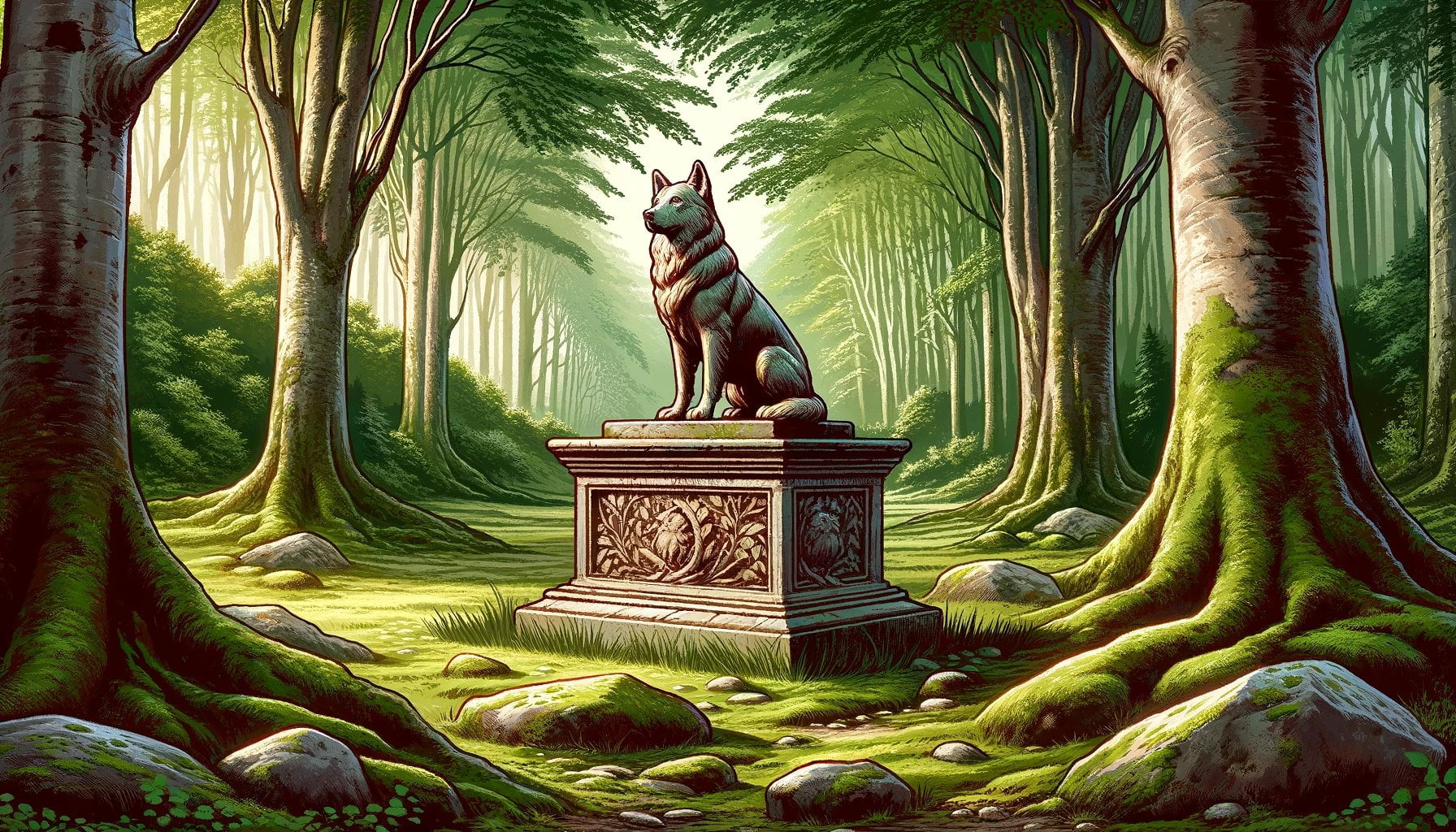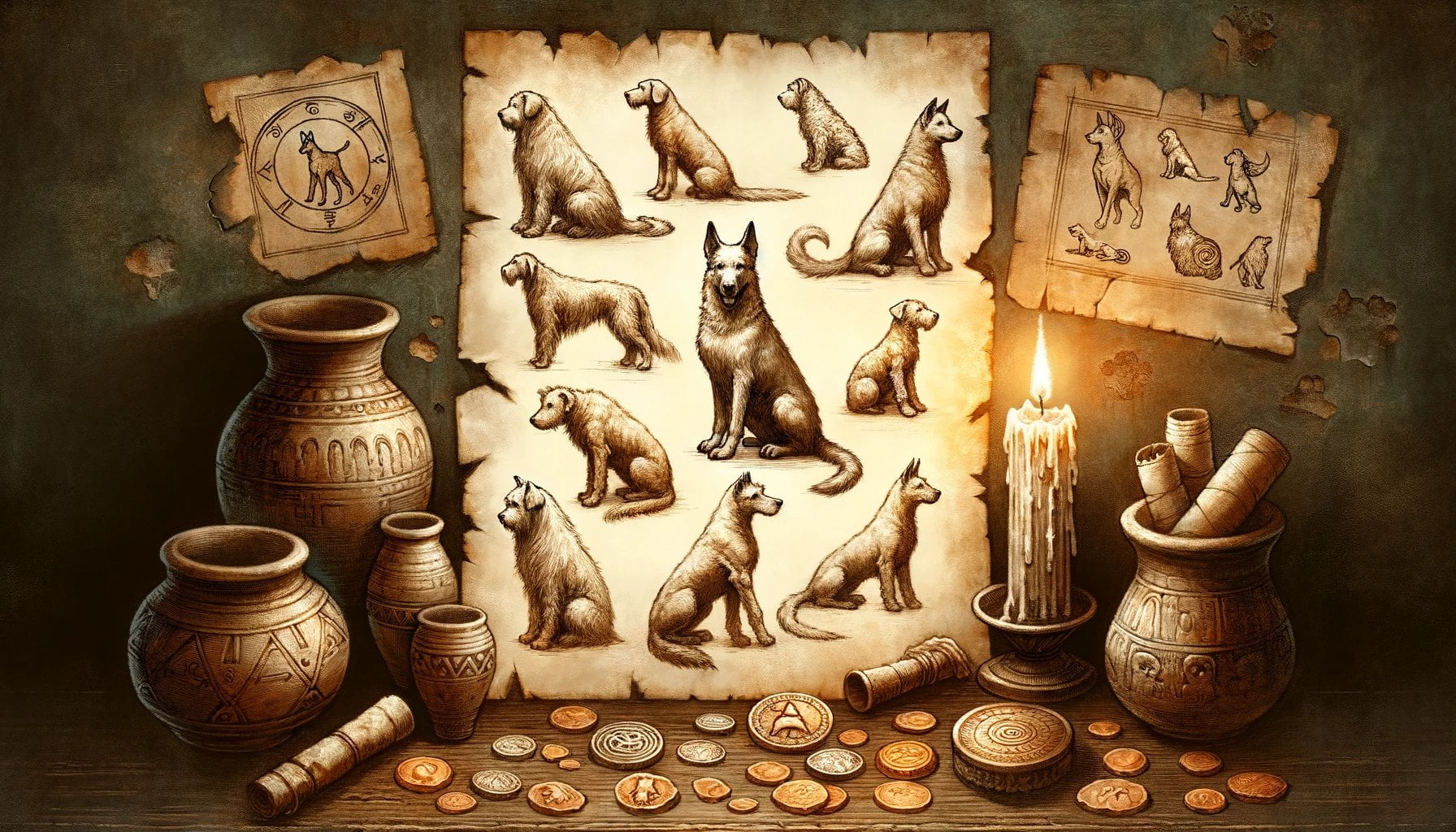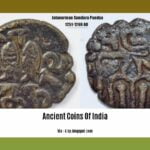Embark on a captivating journey into the depths of antiquity as we explore the intriguing world of ancient dog epitaphs. In this article, titled “Exploring Ancient Dog Epitaphs: A Fascinating Journey into Antiquity,” we delve into the rich history and profound significance of these long-forgotten tributes to our faithful canine companions. Discover the secrets behind these ancient inscriptions, which offer a glimpse into the deep bond between humans and dogs throughout the ages. Through extensive research and a passion for ancient history, this article brings these captivating stories to life, shedding light on a subject often overlooked in the annals of history.

Key Takeaways:
- Ancient dog epitaphs were heartfelt and emotional, showcasing the deep bond between humans and their canine companions.
- Examples of dog epitaphs include expressions of grief, admiration for their qualities, and gratitude for their loyalty.
- Epitaphs were not exclusively written for dogs, as other animals like parrots and locusts also received such tributes.
- Both ancient Greeks and Romans wrote epitaphs on tombstones for their beloved dogs.
- Dogs held significant value and were cherished as important companions in ancient Greece and Rome.
- The death of pets, including dogs, has been a source of sorrow since ancient times.
- Epitaphs for hunting dogs emphasized their importance and likened them to brave soldiers on the battlefield.
- Archaeologists have discovered ancient dog tombs adorned with mournful epitaphs.
- The presence of epitaphs for dogs highlights the enduring appreciation for their companionship and loyalty throughout history.
Ancient Dog Epitaphs
Ancient civilizations, such as the Greeks and Romans, held a deep affection for their furry companions, resulting in the creation of heartfelt epitaphs to honor their departed dogs. These epitaphs provide us with a glimpse into the emotional bond shared between humans and canines in antiquity.
A Testament to Love and Loss
Ancient dog epitaphs were known for their touching and emotional nature. They served as heartfelt tributes to beloved pets and expressed the immense grief experienced by their human counterparts upon their passing. One such epitaph read, “I am in tears, while carrying you to your last resting place as much as I rejoiced when bringing you home in my own hands fifteen years ago.”
Celebrating Canine Virtues
These epitaphs often celebrated the unique qualities and virtues displayed by dogs. The ancient Greeks and Romans acknowledged their companions’ loyalty, intelligence, charm, and affection. One epitaph eloquently summed up these qualities, stating, “Beauty, intelligence, affection, and cheerfulness.”
The Importance of Canine Companions
Ancient Greeks and Romans regarded dogs as valuable and important companions. Dogs were not merely kept as working animals or guards but were deeply treasured as members of the family. Their loss was mourned openly, with grieving owners penning epitaphs that conveyed their sorrow. The epitaphs served as a testament to the emotional impact that the dogs had on their human families.
The Symbolism of Hunting Dogs
Hunting dogs held a special place in ancient society, and their epitaphs often compared them to brave soldiers on the battlefield. These epitaphs highlighted the dogs’ significance and the role they played in the hunt, likening their loyalty and dedication to that of a fellow warrior. This symbolism further emphasized the importance of these animals in ancient civilizations.
Archaeological Discoveries and Their Significance
Archaeologists have unearthed ancient dog tombs that contained touching epitaphs. These discoveries provide tangible evidence of the value placed on dogs in antiquity and offer a glimpse into the profound grief experienced by their owners. These emotional tributes are a testament to the enduring bond between humans and dogs that transcends time.
Grief Since Ancient Times
The concept of grieving for lost pets, including dogs, is not unique to modern society. In fact, the ancient Greeks and Romans also experienced immense sorrow upon the death of their beloved companions. Epitaphs and tombs dedicated to dogs are a poignant reminder that the pain of losing a pet has been felt throughout the ages.
Ancient dog epitaphs offer us a captivating insight into the deep love and respect that ancient civilizations had for their canine companions. These heartfelt tributes remind us that the bond between humans and dogs is timeless and transcends the boundaries of ancient and modern worlds.
In the ancient times, there was a fierce naval battle that is considered the largest in history. If you want to learn more about this epic clash, click here.
Explore the magnificent palaces of ancient Egypt and marvel at their grandeur. Discover more about these majestic structures by clicking here.
Step into the ancient world of Peru and uncover the secrets of an extraordinary city. To explore this ancient Peruvian city, click here.
Delve into the legends of the ancient Vietnamese warriors and their valorous deeds. Click here to learn more about these ancient heroes.
Unlock the mysteries of ancient Egypt and discover the names of their powerful queens. For a list of ancient Egyptian queen names, click here.
Take a journey back in time and explore the ancient names of Syria. To discover more about these ancient Syrian names, click here.
Experience the grandeur of ancient queens and their remarkable legacies. For a captivating list of ancient queen names, click here.
Uncover the incredible inventions of the ancient Persians that shaped our world. To explore these ancient Persian inventions, click here.
Marvel at the astonishing achievements of the ancient Romans and their enduring legacy. Click here to discover more about the accomplishments of this mighty civilization.
Embark on a journey to Africa and explore the enchanting ancient castles that still stand today. To discover these ancient African castles, click here.
Enter the mythical realm of ancient Greece and explore their awe-inspiring castles. Click here to discover more about these ancient Greek fortresses.
Unveil the marvels of an ancient Italian city and delve into its rich history. For more information about this ancient Italian city, click here.
Different Types of Dog Epitaphs
The ancient Greeks and Romans had a profound love and appreciation for their dogs, which was evident in the touching epitaphs they created to honor their beloved pets. These epitaphs served as a testament to the grief and admiration humans felt upon the death of their loyal companions. Let’s embark on a fascinating journey into antiquity to explore the different types of dog epitaphs that were crafted with utmost care and emotional depth.
Epitaphs Reflecting Grief and Sorrow
Ancient dog epitaphs were infused with an overwhelming sense of sadness and sorrow, mirroring the profound grief experienced by their human counterparts. These epitaphs captured the deep bond between humans and dogs, acknowledging the immense pain felt at their loss. Words such as “tears,” “wet with tears,” and “in tears” conveyed the heartbreak and emotional turmoil experienced by the bereaved owners.
Epitaphs Expressing Loyalty and Virtues
Dogs were not merely regarded as working animals or guards in ancient civilizations; they were valued companions and celebrated for their unique qualities and virtues. Epitaphs beautifully portrayed dogs as loyal, intelligent, charming, and affectionate beings. The epitaphs honored these qualities, emphasizing their significance and the impact they had on the lives of their owners.
Epitaphs Celebrating the Bond Between Humans and Dogs
The relationship between humans and dogs was revered in ancient times, and epitaphs were a way to celebrate this special bond. Ancient Greeks and Romans recognized the invaluable companionship that dogs provided and compared them to brave soldiers on the battlefield. These epitaphs highlighted the dogs’ role as devoted friends and reminded readers of the unwavering love and support they offered throughout their lives.
Epitaphs for Special Dog Breeds
Different dog breeds held distinctive positions of importance in ancient societies. Epitaphs acclaimed the traits and characteristics specific to certain breeds, such as the Molossus of Epirus, the Vertragus, the Lacone, and the Cretan Mastiff, which were highly sought after in ancient Rome. These epitaphs emphasized the significance of these breeds and their contributions to various aspects of ancient life, from guarding to shepherding and even military purposes.
Epitaphs as a Lasting Tribute
Ancient Greeks and Romans deemed it crucial to honor their deceased dogs with epitaphs, treating them as they would any other family member. These heartfelt tributes were engraved on tombstones, commemorating the memory of the cherished pets. Archaeological discoveries of ancient dog tombs further solidify the evidence of the profound value and reverence placed on dogs in antiquity.
Modern Reflections of Ancient Epitaphs
While the practice of crafting dog epitaphs has evolved over time, the essence of honoring and memorializing our beloved pets remains. Today, epitaphs for pets, including dogs, can be personalized to reflect the unique bond shared between the pet and their owner. Modern epitaphs continue to serve as a lasting tribute, encapsulating the deep love and companionship that humans and dogs have cherished throughout history.
Key Takeaways:
– Ancient dog epitaphs conveyed grief and sadness, reflecting the profound sense of loss experienced by their human counterparts.
– Epitaphs celebrated the loyalty, intelligence, charm, and affection displayed by dogs, emphasizing their unique qualities and virtues.
– Ancient Greeks and Romans recognized the significant bond between humans and dogs, portraying dogs as invaluable companions comparable to brave soldiers.
– Epitaphs highlighted the importance of different dog breeds, acknowledging their distinct traits and contributions to ancient society.
– These heartfelt epitaphs served as lasting tributes, recognizing the memory of beloved pets and solidifying the deep value and reverence placed on dogs in antiquity.
Sources:
– The Dodo – 9 Touching Epitaphs Ancient Greeks And Romans Wrote For Their Pets
– Greece High Definition – Ancient Greeks Had a Great Love and Respect for Their Pets
Analysis of Notable Ancient Dog Epitaphs
The ancient Greeks and Romans had a deep love and respect for their dogs, which is evident in the touching epitaphs they wrote to honor their deceased pets. These epitaphs reveal the strong bond between humans and dogs in ancient times. Let’s delve into the fascinating world of ancient dog epitaphs and explore the burial practices, the high regard for dogs, and the emotional connection between humans and their beloved canine companions.
Burial Practices for Dogs
- Ancient Romans treated their dogs with the same respect as humans, creating tombs for them and giving them proper burials[^1^].
- Archaeologists have discovered numerous dog tombs with grief-stricken epitaphs, demonstrating the significance of dogs in ancient burial practices[^2^].
- The use of marble epitaph plaques further emphasizes the love and grief expressed by the owners for their departed canine companions[^3^].
Reverence for Dogs in Ancient Greek and Roman Societies
- Dogs held a high position in ancient Greek and Roman societies, being regarded as faithful companions and symbols of loyalty[^1^][^3^].
- Epitaphs written for dogs were often poetic and emotional, reflecting the deep affection and connection humans had with their pets[^1^][^3^].
- Ancient Greeks and Romans viewed dogs as deserving praise and admiration, highlighting their qualities and virtues such as loyalty, intelligence, charm, and affection[^1^].
- Dogs were not merely seen as working animals or guards but were considered valuable companions[^5^].
- Hunting dogs in particular held a special place in ancient society and were compared to brave soldiers on the battlefield[^5^].
Emotional Connection and Grief
- The epitaphs convey the deep grief experienced by dog owners upon the loss of their pets, reflecting the strong emotional bond between humans and dogs[^1^].
- Owners openly wept for their departed companions, emphasizing the intensity of the emotional connection they shared[^1^].
- Epitaphs express both joy and sorrow experienced throughout the dog’s life, highlighting the significance of their presence and companionship[^1^].
- Owners acknowledged their dogs’ loyalty and the positive impact they had on their lives[^1^].
Notable Ancient Dog Epitaphs
- “I am in tears, while carrying you to your last resting place as much as I rejoiced when bringing you home in my own hands fifteen years ago”[^1^].
- “Thou who passest on this path, If haply thou dost mark this monument, Laugh not, I pray thee, though it is a dog’s grave. Tears fell for me, and the dust was heaped above me By a master’s hand”[^1^].
- “To Helena, foster child, soul without comparison and deserving of praise”[^1^].
- “This is the tomb of the dog, Stephanos, who perished, whom Rhodope shed tears for and buried like a human”[^1^].
Key Takeaways:
- Ancient Greeks and Romans honored their dogs with heartfelt epitaphs, displaying their deep love and respect for these animals.
- Dogs held a high regard in ancient societies and were considered faithful companions and symbols of loyalty.
- Epitaphs conveyed the grief and deep emotional connection experienced by dog owners upon the loss of their pets.
- Ancient dog epitaphs serve as a testament to the timeless bond between humans and dogs, highlighting the unique qualities and virtues attributed to these loyal companions.
Legacy and Impact of Ancient Dog Epitaphs
Imagine walking through the ancient streets of Greece or Rome, stumbling upon a tombstone adorned with heartfelt words dedicated to a beloved dog. These ancient dog epitaphs provide a glimpse into the emotional connection between humans and their canine companions, transcending time and cultures. In this article, we will explore the legacy and impact of these ancient dog epitaphs, delving into the depths of history to uncover the profound bond shared between humans and dogs.
Key Takeaways: Legacy and impact of ancient dog epitaphs
- Ancient Greeks and Romans expressed their love and grief for their deceased dogs through touching epitaphs, showcasing the deep affection they had for their furry companions.
- These epitaphs serve as a reflection of the strong bond and emotional connection between humans and dogs in ancient times, highlighting the timeless nature of this relationship.
- Epitaphs for hunting dogs depicted them as vital companions and contributors to their owners’ survival, revealing the important role dogs played in ancient societies.
- The discovery of ancient dog tombs with tear-jerking epitaphs by historians emphasizes the value placed on dogs in antiquity and demonstrates the respect and reverence they received.
- These epitaphs offer valuable insights into the cultural significance and societal views towards dogs in the ancient world, shedding light on the way humans cherished and respected their loyal companions.
- The legacy of ancient dog epitaphs shows that the love and devotion people have for their pets transcend time, serving as a reminder of the enduring bond between humans and dogs throughout history.
Citation:
- The Dodo: 9 Touching Epitaphs Ancient Greeks And Romans Wrote For Their Deceased Dogs
- National Geographic: See how dogs were celebrated in the ancient world

FAQ
Q1: What were ancient dog epitaphs?
A1: Ancient dog epitaphs were poetic and emotional inscriptions that the ancient Greeks and Romans wrote to honor their deceased dogs. They expressed love, grief, and the special bond between humans and their canine companions.
Q2: How were dogs buried in ancient times?
A2: Dogs were given proper burials in ancient times. Ancient Romans created tombs for their dogs and treated them with the same respect as humans. Archaeologists have unearthed dog tombs with grief-stricken epitaphs, indicating the importance of dogs in ancient societies.
Q3: What kind of emotional connection did ancient Greeks and Romans have with their dogs?
A3: Ancient Greeks and Romans had a deep love and respect for their dogs. The epitaphs they wrote for their deceased dogs revealed the strong emotional bond they had with their pets. Dogs were viewed as faithful companions and symbols of loyalty.
Q4: What were some examples of ancient dog epitaphs?
A4: Some examples of ancient Greek and Roman dog epitaphs include: “I am in tears, while carrying you to your last resting place as much as I rejoiced when bringing you home,” and “Thou who passest on this path, If haply thou dost mark this monument, Laugh not, I pray thee, though it is a dog’s grave. Tears fell for me, and the dust was heaped above me By a master’s hand.”
Q5: What did ancient dog epitaphs reveal about the importance of dogs?
A5: Ancient dog epitaphs revealed that dogs were highly valued and cherished in ancient Greece and Rome. Dogs were considered important companions, sources of joy and solace, and even compared to fellow soldiers on the battlefield. The epitaphs reflected the deep reverence for dogs and their significant contributions to human lives.
- Senior at What Age: Benefits & Eligibility Guide - March 29, 2025
- Unlocking Senior Benefits: How Old is a Senior? Your Complete Guide - March 29, 2025
- Master Russian Politeness:A Guide to Saying Please - March 29, 2025






![[Ancient Coins of India Price]: Unveiling the Value of Historical Treasures ancient-coins-of-india-price_2](https://www.lolaapp.com/wp-content/uploads/2023/12/ancient-coins-of-india-price_2-150x150.jpg)









